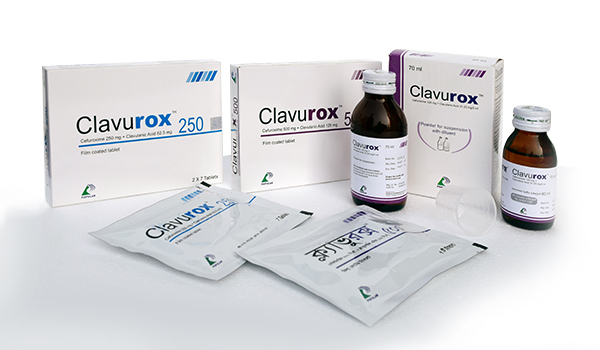Indication
- Pharyngitis/Tonsillitis caused by Streptococcus pyogenes.
- Acute Bacterial Otitis Media caused by Streptococcus pneumoniae, Haemophilus influenzae (including beta lactamase producing strains), Moraxella Catarrhalis (including beta-lactamase producing strains) or Streptococcus pyogenes.
- Acute Bacterial Maxillary Sinusitis caused by Streptococcus pneumoniae or Haemophilus influenzae (non beta-lactamase producing strains only).
- Lower Respiratory Tract Infections including pneumoniae, caused by Streptococcus pneumoniae, Haemophilus influenzae (including beta lactamase producing strains), Klebsiella spp., Staphylococcus aureus (penicillinase and non penicillinase producing strains), Streptococcus pyogenes, Escherichia coli.
- Acute Bacterial Exacerbations of Chronic Bronchitis and Secondary Bacterial Infections of Acute Bronchitis caused by Streptococcus pneumoniae, Haemophilus influenzae (beta-lactamase negative strains) or Haemophilus parainfluenzae (beta-lactamase negative strains).
- Skin and Skin-Structure Infections caused by Staphylococcus aureus (penicillinase and non-penicillinase producing strains), Streptococcus pyogenes, Escherichia coli, Klebsiella spp. and Enterobacter spp.
- Urinary Tract Infections caused by Escherichia coli or Klebsiella pneumoniae.
- Bone and Joint Infections caused by Staphylococcus aureus (penicillinase and non-penicillinase producing strains).
- Uncomplicated and Disseminated Gonococcal Infections due to Neisseria gonorrhoeae (penicillinase and non-penicillinase producing strains) in both males and females.
- Early Lyme Disease (erythema migrans) caused by Borrelia burgdorferi.
- Septicemia caused by Staphylococcus aureus (penicillinase and non-penicillinase producing strains), Streptococcus pneumoniae, Escherichia coli, Haemophilus influenzae (including ampicillin-resistant strains) and Klebsiella spp.
- Meningitis caused by Streptococcus pneumoniae, Haemophilus influenzae (including ampicillin resistant strains) Neisseria meningitis and Staphylococcus aureus (penicillinase and non-penicillinase producing strains).
- Switch Therapy (injectable to oral) after surgery when patient's condition is improved.
Dosage & Administration
Adolescents & Adults:
|
Infection |
Dosage |
Duration (days) |
||
|
Pharyngitis or Tonsillitis |
250 mg b.i.d |
10 |
||
|
Acute Bacterial Maxillary Sinusitis |
250 mg b.i.d |
10 |
||
|
Acute Bacterial Exacerbation of Chronic Bronchitis |
250-500 mg b.i.d |
10 |
||
|
Secondary Bacterial Infections of Acute Bronchitis |
250-500 mg b.i.d |
5-10 |
||
|
Community Acquired Pneumonia |
250-500 mg b.i.d |
5-10 |
||
|
Complicated Skin & Skin-Structure Infections |
250-500 mg b.i.d |
10 |
||
|
MDR Typhoid Fever |
500 mg b.i.d |
10-14 |
||
|
Uncomplicated Urinary Tract Infection |
250 mg b.i.d |
7-10 |
||
|
Uncomplicated Gonorrhea |
1000 mg b.i.d |
single dose |
||
|
Lyme Disease |
500 mg b.i.d |
20 |
Paediatric patients (3 months to 12 years) :
|
Infection |
Dosage |
Duration (days) |
||
|
Pharyngitis or Tonsillitis |
20 mg/kg/day in two divided doses |
5-10 |
||
|
Acute otitis media |
30 mg/kg/day in two divided doses |
10 |
||
|
Acute bacterial maxillary sinusitis |
30 mg/kg/day in two divided doses |
10 |
||
|
Community acquired pneumonia |
30 mg/kg/day in two divided doses |
5-10 |
||
|
MDR Typhoid fever |
30 mg/kg/day in two divided doses |
10-14 |
||
|
Complicated skin & skin-structure infections |
30 mg/kg/day in two divided doses |
10 |
||
|
Uncomplicated urinary tract infection |
20 mg/kg/day in two divided doses |
7-10 |
Directions for reconstitution of suspension
Shake the bottle well to loosen the powder. Now pour the diluents completely into the bottle of powder. Close the bottle tightly & shake vigorously until it is properly mixed. The suspension is ready for use. After reconstitution the suspension may be used within 10 days if kept at normal temperature or within 14 days if kept in refrigerator.
Precautions
Cefuroxime & Clavulanic Acid should be given with care to patients receiving concurrent treatment with potent diuretics & who have history of colitis.
Use in Pregnancy & Lactation
During pregnancy: While all antibiotics should be avoided in the first trimester if possible. However, Cefuroxime & Clavulanic Acid can be safely used in later pregnancy to treat urinary and other infections.
During lactation: Cefuroxime & Clavulanic Acid is excreted into the breast milk in small quantities. However, the possibility of sensitizing the infant should be kept in mind.

